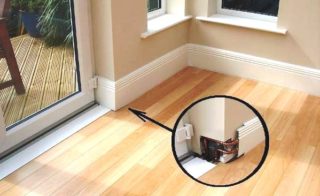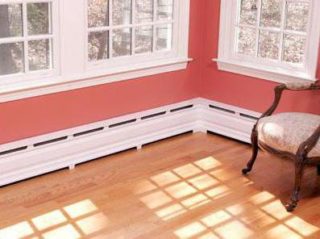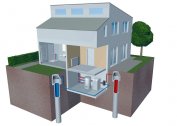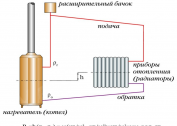The autonomous and central heating system is not always able to qualitatively warm the room throughout. Convection leads to the fact that warm air accumulates near the ceiling, and remains cold in the floor area. This causes discomfort and is fraught with colds. The way out of this situation is plinth heating, which can be an auxiliary or main source of heat.
The main types of baseboard heating
The plinth heating system is a compact equipment that is installed on the floor along walls that are not covered by cabinet furniture. The rectangular case is made of aluminum. In the vertical and horizontal planes of the product have slots designed for intake, heating and air outlet.
Heating skirting boards, depending on the coolant used, are available in this design:
- Electric. Plinth-electric heaters are made of cables, tubes and ribbons. Products are connected to 220 V sockets and consume energy of 150-280 W per linear meter. To increase the efficiency of work and reduce the cost of bills, electric skirting heaters are equipped with electronic control units.
- Water. Water heating plinth is an analogue of the “warm floor” system with the difference that the communication is not walled into concrete, but laid directly on the surface, followed by covering with a box. The installation kit consists of a radiator block, a distribution manifold and plastic pipes.
When choosing warm plinths for heating in the house, it is necessary to take into account their architectural features, the cost of energy and equipment, their own abilities, if the installation is done on their own.
Principle of operation
Unlike convector-type heaters, the plinth heating radiator works according to the principle of the distribution of warm air along the walls on which it is installed. Due to this, the high temperature is concentrated from below, gradually decreasing as the heated masses move to the ceiling.
The walls play the role of a screen, reflecting them in the center of the room. Part of the heat is generated by the metal baseboard battery. Thanks to this solution, a uniform distribution of generated energy is ensured over the entire volume of the room, and an optimum level of comfort in the floor area is achieved.
Advantages and disadvantages
Plinth heating electric and water has the following advantages:
- noiselessness;
- compactness;
- uniform heat distribution;
- heating of walls, which eliminates the risk of fungus and mold;
- excellent adaptation to any interior;
- ease of installation;
- quite high efficiency;
- constant access for inspection, maintenance, repair and modernization;
- the ability to adjust the temperature in each room separately, including remotely.
The disadvantages of these devices are also available:
- quite high initial investment in the purchase of equipment and its installation;
- restrictions on the length of the water circuit (not more than 15 m);
- high electricity costs;
- baseboard radiator can not be decorated, covered with furniture and other interior elements.
With regard to the aesthetic characteristics of the system, everything is decided by the taste of the consumer. One person will like their appearance, and the other will speak out negatively.
Technical characteristics of skirting heaters
Specifications vary depending on the type of equipment and brand of the manufacturer. Among domestic models, the Breeze plinth heater looks advantageous, which has good efficiency, with sufficient power and reliability.
Main parameters of heaters:
- working temperature - + 50-85ºС;
- pressure in water systems - up to 3 atm;
- box height - 12-18 cm;
- baseboard width - 4-6 cm;
- power - 150-280 W / lm;
- heating area 1 lm - 4-6 m²;
- sections length - 100 cm and 200 cm;
- set price - 2000-7000 rub / lm;
- estimated service life - 10 years.
For the installation of a water, cable or tape infrared warm skirting board, the masters will take 10-30% of the cost of the material.
Baseboard heating application
Despite the fact that this system was invented more than a century ago, it has not yet found wide application in domestic and industrial fields. At the same time, the possibilities of baseboard heaters are quite wide. They can be used as auxiliary heating in large rooms or basic for small rooms.
Products can be successfully used for heating areas of this type:
- city apartments and private houses: halls, bedrooms, kitchens, loggias;
- cottages and cottages;
- warehouses, bases, closed hangars;
- kindergartens;
- school classes;
- Offices
- outlets: shops, stalls, pavilions;
- studios, salons, clubs;
- public places: theaters, museums.
Skirting-type heaters do not clutter up the walls, providing additional space and space for the placement of interior elements or decorations.
System installation
Do-it-yourself installation of underfloor heating will save a considerable amount on the services of specialists. In addition, the installation process will allow you to study the heater device, which will subsequently facilitate its repair and maintenance.
The assembly of the electrical device is carried out in the following sequence:
- marking, gluing thermal insulation tape to the wall;
- installation of fasteners with an interval of 40 cm;
- laying and fixing of the line;
- connecting the heater to the network, checking its operability;
- closing elements with decorative overlays.
To be able to adjust the temperature in automatic mode, the system is connected to the electronic control unit.
Water heating is collected in this order:
- fixing the wall strip;
- installation of distribution manifold and inlet crane;
- laying of the circuit, connection of the segments with crimp fittings;
- connecting the circuit to the collector, checking the line for leaks;
- fastening of a decorative plinth.
It is advisable to install water devices in private houses, where heating is carried out by its own boiler with a built-in pump. Electrical products are best placed in multi-storey buildings where the use of water circuits is prohibited.
Popular manufacturers
In specialized stores and on Internet portals, a wide selection of baseboard heating systems from domestic and foreign manufacturers is presented.
Most popular brands:
- Breeze;
- Megador
- Best Board
- Thermodul;
- Mr.Tektum.
When choosing a system, one should focus not only on price, but also on user reviews that provide real information about the properties, advantages and disadvantages of devices.







